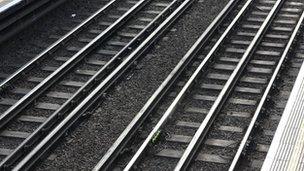High levels of metal in underground air raise concerns
- Published

Tiny particles are thrown up when wheels run on metal tracks
Questions have been raised over the health impact of high levels of tiny airborne metal particles discovered in a European underground train system.
Millions of people travel on underground urban transit systems in cities across the world.
Researchers at Southampton University say metal in the air thrown up by trains running on metal tracks could pose a health risk.
Airborne particles small enough to be inhaled are known to damage health.
They increase the risk of developing asthma, lung cancer or cardiovascular disease.
The new study looked at how much metal this so-called particulate matter is contained in the air of underground train systems.
Matt Loxham, a medical biologist at Southampton University, collected minute dust particles of different sizes from at an underground train system in an unnamed European city.
The dust was collected for up to 10 hours a day, across the morning and evening rush hours.
Pollution monitors often collect particulates that measure 10 micrometres across, known as PM10s, as well as the smaller PM2.5s. For this study they also looked at even tinier particles: so-called 'ultrafine' particles or PM 0.1s.
All sizes of particles they collected contained a lot of iron - up to half of their weight. They expected to find a high metal content among the larger particles - PM10s and PM 2.5s, but it surprised them to find such high levels in even the very smallest ones.
Matt Loxham has a theory for how the metals get into the dust.
"It's almost certainly from the wheels on the tracks, from the braking system of the train, and when the train draws power from overhead cables or from a third rail. You can sometimes see bright flashes - that's actually hot enough to vaporise very small amounts of metal."
Laboratory findings
Although the effects of the metals in this dust have not been studied directly in humans, their behaviour in the laboratory has been observed.
The metal particles combine with oxygen.
Matt Loxham said: "These chemicals have the potential to react with molecules within cells - proteins and fats within a cell - and may be able to alter the properties and functions of those molecules
"Healthy travellers shouldn't be worried, but the dust may have more pronounced effects on people with underlying respiratory conditions, such as asthma."
Dr John Moore-Gillon, a spokesman for the British Lung Foundation, said that the work was interesting - and that it was encouraging that any potential problems were being investigated now, rather than waiting for them to emerge.
"They looked at very fine particles 100th the size of those often looked at, the PM10s, which we know can cause lung disease. And we know that metals can cause problems with the way cells work.
"The bottom line is this demonstrates a need for further studies."
Matt Loxham agreed more work is needed, as studies on underground railway workers have been far from conclusive.
He said: "Some tests showed raised levels of molecules in the blood that indicated inflammation, or a slight tendency towards increased blood clotting. Others showed very little effect at all."
- Published25 June 2010
- Published8 March 2013